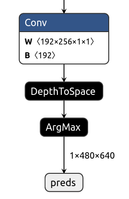- Mark as New
- Bookmark
- Subscribe
- Mute
- Subscribe to RSS Feed
- Permalink
- Report Inappropriate Content
System information (version)
- OpenVINO => 2021.3.394
- Operating System / Platform => Ubuntu 18.04 64Bit
- Compiler => g++ 7.5.0
- Problem classification: Inference, model optimization
- Framework: Pytorch -> ONNX -> IR
- Model name: BiseNet
Detailed description
I have been working on a semantic segmentation model for a custom industrial application. The results from the Openvino framework is very different from the results i get from Pytorch. Please refer to the images, the first image is the segmentation result of Pytorch and the second is the segmentation results from OpenVino C++ API:
Please refer to the usage of Model Optimizer as shown below:
python3 /opt/intel/openvino_2021/deployment_tools/model_optimizer/mo.py -m ~/openvino_models/onnx/bisenet_v1.onnx\
-o ~/openvino_models/ir --input_shape [1,3,480,640] --data_type FP16 --output preds\
--input input_image --mean_values [123.675,116.28,103.52] --scale_values [58.395,57.12,57.375]
I perform a normalization of image during training and hence I have used the same parameters(mean and variance/scale). I did a quick analysis of the onnx model and IR model from Openvino. I found one striking difference which is a bit weird. The ONNX model has only one output as in the original model while the IR format has 2 outputs.


My Inference Engine integration code:
InferenceEngine::Core core;
InferenceEngine::CNNNetwork network;
InferenceEngine::ExecutableNetwork executable_network;
network = core.ReadNetwork(input_model); /// input_model is a string path to the .xml file
Input Settings: Since my network work on RGB colour format, I perform a conversion from BGR -> RGB:
InferenceEngine::InputInfo::Ptr input_info = network.getInputsInfo().begin()->second;
std::string input_name = network.getInputsInfo().begin()->first;
input_info->setPrecision(InferenceEngine::Precision::U8);
input_info->setLayout(InferenceEngine::Layout::NCHW);
input_info->getPreProcess().setColorFormat(InferenceEngine::ColorFormat::RGB);
Output Settings: I use the `rbegin()` function instead of `begin()` to access the second output of the network as it is the desired output and the first output is just created during the model optimization step which I don't understand :(. The model has a 64 bit integer output but I set it to 32-bit int. The ouput layout is CHW with C always one and the values of the H x W represent the corresponding class of the that pixel.
InferenceEngine::DataPtr output_info=network.getOutputsInfo().rbegin()->second;
std::string output_name = network.getOutputsInfo().rbegin()->first;
output_info->setPrecision(InferenceEngine::Precision::I32); ///The model has a 64 bit integer output but I set it to 32-bit int output_info->setLayout(InferenceEngine::Layout::CHW);
Creation of Infer-request and input blob and inference
InferenceEngine::InferRequest infer_request = executable_network.CreateInferRequest();
cv::Mat image = cv::imread(input_image_path);
InferenceEngine::TensorDesc tDesc(
InferenceEngine::Precision::U8, input_info->getTensorDesc().getDims(), input_info->getTensorDesc().getLayout()
);
InferenceEngine::Blob::Ptr imgBlob = InferenceEngine::make_shared_blob<unsigned char>(tDesc, image.data);
infer_request.SetBlob(input_name, imgBlob);
infer_request.Infer();
Random Color palette for visualization of the result
std::vector<std::vector<uint8_t>> get_color_map()
{
std::vector<std::vector<uint8_t>> color_map(256, std::vector<uint8_t>(3));
std::minstd_rand rand_engg(123);
std::uniform_int_distribution<uint8_t> u(0, 255);
for (int i{0}; i < 256; ++i) {
for (int j{0}; j < 3; j++) {
color_map[i][j] = u(rand_engg);
}
}
return color_map;
}
Decoding of the blob
InferenceEngine::Blob::Ptr output = infer_request.GetBlob(output_name);
auto const memLocker = output->cbuffer();
const auto *res = memLocker.as<const int *>();
auto oH = output_info->getTensorDesc().getDims()[1];
auto oW = output_info->getTensorDesc().getDims()[2];
cv::Mat pred(cv::Size(oW, oH), CV_8UC3);
std::vector<std::vector<uint8_t>> color_map = get_color_map();
int idx{0};
for (int i = 0; i < oH; ++i)
{
auto *ptr = pred.ptr<uint8_t>(i);
for (int j = 0; j < oW; ++j)
{
ptr[0] = color_map[res[idx]][0];
ptr[1] = color_map[res[idx]][1];
ptr[2] = color_map[res[idx]][2];
ptr += 3;
++idx;
}
}
cv::imwrite(save_pth, pred);
Could you please tell me if I am doing something wrong? Please feel free to ask for more details.
Link Copied
- Mark as New
- Bookmark
- Subscribe
- Mute
- Subscribe to RSS Feed
- Permalink
- Report Inappropriate Content
@Eashwar there are several semantic segmentation models demonstrated to work with OpenVINO, you may find them with OpenVINO Open Model Zoo, see for Intel and Public pre-trained segmentation models. You may see how they work with OpenVINO and how processing of their output implemented in appropriate Open Model Zoo demos, Image Segmentation Python Demo and Image Segmentation C++ Demo
Hope, this helps
- Mark as New
- Bookmark
- Subscribe
- Mute
- Subscribe to RSS Feed
- Permalink
- Report Inappropriate Content
@Vladimir_Dudnik Thanks for the above recommendations. We are particularly interested in a custom segmentation model as it meets our requirement and I would like to integrate Openvino in my project. I had a look in the C++ segmentation demo and I really can't find what might be wrong with my code. I see that post-processing is very similar. Do you find any other issue in my integration code that would be causing this bug?
- Mark as New
- Bookmark
- Subscribe
- Mute
- Subscribe to RSS Feed
- Permalink
- Report Inappropriate Content
@Eashwar thanks for your interest to OpenVINO and we are definitely in charge to help you to run your model with OpenVINO. I do not see issues from the C++ code point of view. We probably need to start from model analysis. If you can't share your particular model, you probably could point us to some public model which may looks similar to your, so we can check what might need to be changed to get it work with OpenVINO?
- Mark as New
- Bookmark
- Subscribe
- Mute
- Subscribe to RSS Feed
- Permalink
- Report Inappropriate Content
Hi Eashwar93,
This thread will no longer be monitored since this issue has been resolved in OpenVINO ™ GitHub at the following post:
https://github.com/openvinotoolkit/openvino/issues/6404
If you need any additional information from Intel, please submit a new question.
Regards,
Wan
- Subscribe to RSS Feed
- Mark Topic as New
- Mark Topic as Read
- Float this Topic for Current User
- Bookmark
- Subscribe
- Printer Friendly Page

